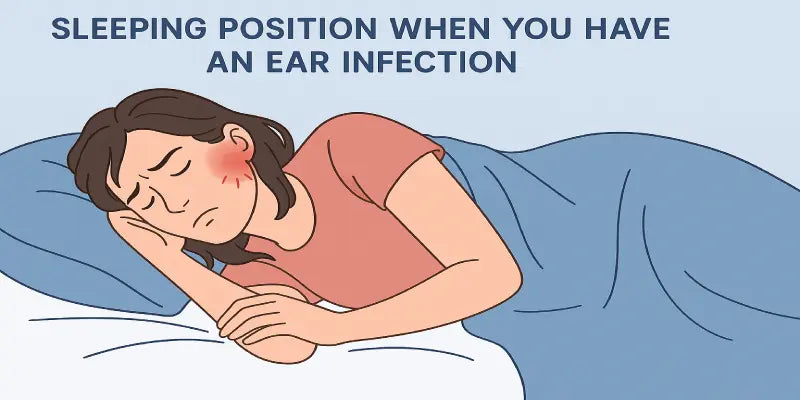
Sleeping Position When You Have An Ear Infection
Sleep is an important part of healthy living that has no alternative. The key to relaxing your brain and supporting body functions requires optimum energy levels fueled by deep and uninterrupted sleep. Different types of ear pain, caused by ear infections, however, can interrupt such sleep.
Consistent ear pain puts pressure in the way of your sleep. Such pain is often triggered by inner ear infections that elevate when he/she is lying down on the bed. This raises the discomfort level in the body, making sleep next to impossible.
This guide explores how such infections impact sleep, how to sleep with ear pain, and how to treat it. Additionally, it shares information on the causes of inner ear infections.
What Causes Ear Pain?
An ear infection is what causes ear pain. When viruses or bacteria enter the body via the middle ear, ear infections begin, leading to several medical conditions. These medical conditions (like cold, flu, or allergy) enlarge the throat and nasal airway.
Otitis Media is the most prevalent form of ear infection. It is the middle ear infection that includes swelling and tissue inflammation, triggering significant pain and discomfort. The middle ear is present behind the eardrum and is made of small auditory bones that assist with hearing.
Note: Ear infection occurrence
Ear infections that interrupt sleep and impact the overall well-being, are most common in children. Adults too experience this discomfort.
What are the Symptoms of Ear Infection?
In general cases, the symptoms of an ear infection include a feeling of rotation, which is short-lived. In some cases, when the sensations continue, it implies that the inner ear is impaired.
Furthermore, when the sound signal transmission to the inner ear is minimized, it means that the middle ear is impaired.
Here is the list of the ear infection symptoms:
- Liquid discharge from the ear, either bloody or yellow
- The impacted ear is experiencing ringing sensation
- Intense ear pain
- Partial hearing impairment in the impacted ear
What are the Different Types of Ear Pain?
As per ENT specialists, ear pain is classified under two main heads:
- Primary Ear Pain- The place of origin of this pain is your ears.
- Secondary Ear Pain- This pain is triggered when the nerve connecting the ear and the surrounding body parts have the same neural pathway linked to the brain.
How Ear Infections Impact Your Sleep?
Discomfort and stress in the ear canal, possibly due to ear infections, keep you alert at night, interrupting sleep. Sleep is vital for the healing and recovery of the body. Inadequate rest postpones recovery, creating a damaging cycle for the body.
Interrupted Sleep Routines
Just one night of improper sleep leads to daytime tiredness. Ear pain disturbs your sleep, keeping you awake at night, and leading to late awakening the next day. Consequently, sleeping the following night becomes difficult, since the normal sleep cycle is disrupted.
Chronic Infection Cycle
To battle any kind of infection and deal with swelling or inflammation, Cytokines are required. Cytokines are produced during sleep. Inadequate sleep does not produce enough cytokines, extending the pain and infection duration.
Delayed Recovery Procedure
Sleep is always recommended by doctors and health experts for quicker recovery and healing. Hence, improper sleep damages the immune system of the body, contributing to a higher infection rate.
Note: Poor sleep schedule leads to poor healing of the body. Hence, ear infections continue to interrupt sleep.
What Side Should I Sleep on with a Ruptured Eardrum?
Often a tear occurs in the ear membrane that assists with hearing, due to fluctuations in pressure, infections, or physical damage. This tear is termed as Ruptured Eardrum and it causes consistent discomfort and sleep interruptions.
Often, people who have experienced this pain, wonder, “What side should I sleep on with a ruptured eardrum”?
Here are the best positions to sleep with a ruptured eardrum:
Sleeping on the Uncompromised Side
To prevent any discomfort, keep the infected ear facing upwards and sleep on the side with the normal ear. This will help to fix the infection quickly, due to improved drainage and airflow.
Raised Back Sleeping
Use an additional pillow below your upper back or neck. This will put the head in an elevated position and promote drainage of the fluid from the infected ear.
Microfiber pillow that provides superior support, can minimize strain on the infected ear and enhance comfort.
What is the Treatment for Ear Infection at Home?
There are multiple home remedies available to deal with painful earaches and contribute to healing/recovery.
Here is the list of the treatments:
Use Cold or Hot Pressure
To heal ear pain, cold and hot compress works best. Ice makes the pain dull and minimizes swelling, while heat promotes muscle relaxation and enhances blood flow. Apply cold and hot compress for 30 minutes to get the maximum advantage.
Address the Cold Symptoms
Addressing cold symptoms often helps to treat ear pain. It is crucial to manage ear pain to avoid any kind of respiratory infections. Take these measures:
- Use a room humidifier
- Consume decongestant medication
- Rest often
- Mix honey with warm tea and drink it
- Drink lots of hydrating agents
Over-the-counter (OTC) Medicine
For adults and children experiencing acute ear pain, certain pain management pharmaceutical drugs are available. These medications include Ibuprofen and Paracetamol.
Neck Management Exercises
Perform neck exercises to release stress and lower pain caused by inflammation near the ear canal. Here are the steps:
- In slow circles, turn the head.
- Lend an ear towards the shoulder then change sides.
- Move your shoulder up and down.
- Now open the mouth as big as possible.
Sleep Position Alteration
Ear pain is related to sleep. Change the following things while sleeping to manage your ear infection:
- Sleep on the other side if one ear is infected.
- To keep the impacted ear side slightly elevated, use pillows for your head.
- Sleep on your back when both ears are impacted.
Ginger
Address your swelling issues with Ginger which has several anti-inflammatory properties.
Hydrogen Peroxide
All the germs accumulated inside your ear can be cleaned with Hydrogen Peroxide. Here are the steps to do it:
- Slightly bend the head.
- Put some Hydrogen Peroxide drops in the ear with a dropper.
- Wait for some time and the wax will break down.
- Discharge the liquid and rub your ear.
Sip and Swallow
The first question is how to get deep sleep, so drink small sips of water prior to bed or during the night to manage ear infections. Before sleeping, perform swallowing and neck exercises for better relaxation.
Additional Tips for Sleeping with Ear Infection
Perform the following tips with these ear-friendly tips:
Enhance Airflow
To boost the airflow and manage the ear infection, ensure the blankets and hair do not touch the ear.
Utilize a Good Mattress
Only with a supportive and good-quality mattress can you get good sleep. Only good sleep helps in healing the ear infection.
Consult a Doctor
Talk to a doctor in case the ear infection is severe. Look for other infections or wounds. Take medical help only when you feel dizzy, experience headaches, feel nausea, have a fever, etc.
Even though general eardrum injuries recover in some weeks, however, the ones with bone damage require surgery.
FAQs
Q1: Can over-the-counter pain medicine be used?Ans: Yes, using over-the-counter pain medicines is safe to use. Implement the dosage instructions given on the label of medicines like Ibuprofen. Also, talk to a doctor if you feel it is risky.
Q2: How can ear infections be healed?Ans: Usually, most ear infections are healed without treatment. In some cases, rest is needed. In case the scenario worsens or symptoms do not fade, talk to a doctor. A complete restful sleep also aids the body in dealing with such disorders.
Q3: How prevalent are ear infections?Ans: Children experience ear infections more compared to adults. Usually, children get such infections before the age of three. Hence, keeping a healthy immune system is a must. Use microfiber pillows for a peaceful and pain-free sleep.








